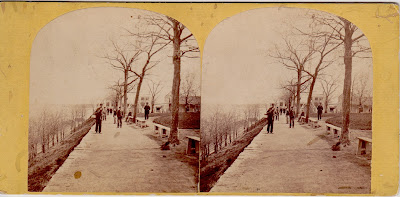Earlier this summer, Peter Pehrson acquired for his Stoddard Corner Bookshop the remaining inventory from New York Bound, the bookshop dedicated to rare, out-of-print, and new books and ephemera related to New York history, located, until 1997, in the lobby of 50 Rockefeller Plaza. Among the treasures in that collection, Pehrson recently discovered this stereoscopic view of Promenade Hill, back in the day when it was called Parade Hill.
Gossips has shared this image before, although not in stereoscopic form, then focusing on the stairs that appear to be going down the face of the bluff. That stair or ladder and the absence of the iron fence led to the conclusion that the men in the picture are masons and laborers working on the retaining wall and this picture was probably taken in 1878, the year the retaining wall was constructed and the iron fence installed.
The stereoscopic image seems to draw more attention to this mysterious object in the background and makes one wonder what it is. Pehrson mused that the picture is too early for this to be a radio tower and the structure seems too small to be a fire tower--even if it's possible to believe that such a thing would ever have been sited on Parade Hill. Gossips' guess is that this structure is some kind of elaborate scaffolding around a flag pole--either one in the process of being erected or one that had been there for a while and required some additional support.
The colorized engraving below, from Wade & Croome's 1846 Panorama of the Hudson River from New York to Albany, discovered and published by The Valley Alliance back in 2011, shows a flag pole on Parade Hill in 1846. A newspaper article discovered by Gossips indicates that in 1898, there was no flag pole on Promenade Hill and the Common Council seemed uncertain about who had the responsibility or authority to put one there. One wonders what the situation of the flag pole was in 1878, if the picture that inspired this rumination was in fact dates from 1878.




.jpg)
Would that be the octagonal tea house with observation deck and pole sticking up from the middle?
ReplyDeleteI reckon not, Vincent. That was destroyed before the invention of photography.
DeleteUsing some reasonable magnification from a professional-grade glass, the structure supporting the vertical piece is open to the ground, and seems to have a fence around it...so I'd veto the teahouse notion. Are there aerial or bird's-eye map views which might explain more?
DeleteAccording to Byrne Fone, a flag was flown at the site up until 1835, the same year the park was officially named "Parade Hill."
ReplyDeleteViewing the image stereoscopically (as intended) brings it to life in 3 dimensions. First enlarge the image on your screen, then lean back and gently cross your eyes until left and right overlap.
Notice that the benches were originally in a more openly social position, across from the precipice and wide open to passersby. I'd imagine that this was a result of the beautification effort that took place in the park in the early 1830s, around the time of Tocqueville's first visit to America. (The democratic positioning of the benches would not have been lost on Tocqueville).
Today the benches are on the other side of the path, immediately facing the rail. But if landscape viewing is ridiculously obscured for sitters, at least we're spared the social interactions of a disintegrating society!
I'm being facetious of course. Whoever sited the benches across the path from their original positions was an aesthetic imbecile and a planner with no sense of history and the shallowest of social aptitudes. Who else would we put in charge of such things?!
I see a weather vane on the very top of the tower (notice the S and N) and a horizontal axis wheel (looks about 4 feet diameter), which may have been a wind speed indicator.
ReplyDeleteMichael--That's so interesting. In the 1898 article I make reference to, it is reported that the Common Council has been quoted a price for a flag pole with a weather vane and without one.
DeleteI suggest this tower is a public weather station, designed to be viewed from a distance to allow residents to know the wind direction and speed at the riverfront at a glance.
ReplyDeleteThe tower has a weather vane on the very top, with the (very large) letters "S", "W" and "N" visible. Below the vane is a horizontal axis wheel with tags or vanes. The wind would have spun the wheel and the tags would have made the wind speed visible to the observers.
"By George, I think he's got it!"
ReplyDeleteHow did you discern this? By electronically enlarging in something like Photoshop, or just using a better magnifying glass?
None of the above.
DeleteHe was the one who placed it there.
(Sorry MO'H, I couldn't resist!)
I save the image to my computer and view it using Picasa (a free application downloaded from Google). I allows me to magnify the image, but the quality of the original scan or photo limits the quality of the enlargement. These images are pretty good to start with, so some of the smaller details are still sharp when magnified.
DeleteThat N & S is clear on the third and most vertical image that Gossips provided. Great catch Michael! I'm amazed at the wooden benches. The park must have been in a transitional phase.
ReplyDelete